This post came together like a puzzle. Pieces came from diverse sources – Chris Burford, Bill Wakefield, Paul Peterson, Rob Thomson, Jim Klein, Rob Klein, Bill Wien, and George Toma. Supporting roles were played by Irv Blond, Jim Polsinelli, Stan Bushman and Joe Ungaschick. A prime example of the small world of Kansas City.
The star of the story is H. Roe Bartle who served as mayor of Kansas City from 1955 to 1963. He is best remembered by KC sports fans for his influential role in bringing pro football to Kansas City in 1963 (and that his nickname “Chief” was the inspiration for naming the Chiefs).
Two personal qualities were well known to Bartle’s constituents. He was a popular and motivational public speaker with a booming voice. And he was a large man (a “colossus” per Forbes Magazine), and that is the basis for today’s Hot Stove story.
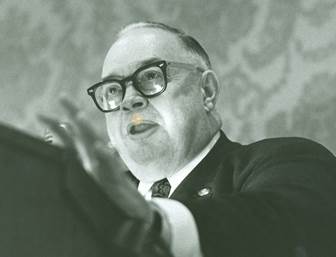
Mayor Bartle and Pro Sports in KC: When Bartle ran for Kansas City mayor in 1955, he had not previously run for political office. However, he was well known because of his leadership role in the Kansas City Area Council of the Boy Scouts of America. To thousands of boys and parents involved in scouting, he was known as “Chief,” a title referencing his leadership of the Tribe of Mic-O-Say, an honor camper program at the Boy Scout camp Bartle created in Osceola, Missouri.
Bartle won that first race and was reelected in 1959. His two terms in office were bookended by two pro sports teams moving to Kansas City – the baseball Philadelphia A’s in 1955 and the football Dallas Texans in 1963. The moves by the teams had a similar pattern.
The A’s to KC in 1955: Philadelphia had two MLB teams for decades – The Phillies in the NL and A’s in the AL. The Phillies had become the dominant baseball team in the city, and the A’s owners (Connie Mack and sons) were looking for a buyer. After the 1954 season, Kansas City mayor William E. Kemp and the KC business community united to lure the A’s to Kansas City, including a promise to new A’s owner Arnold Johnson to expand Municipal Stadium by adding a second deck. The effort to get the team was strongly supported by the Kansas City Star and its Sports Editor Ernest Mehl (who wrote a book about it). Mayor Kemp’s term in office ended on April 11, 1955. He was succeeded by H. Roe Bartle who was mayor for the Kansas City A’s inaugural game on April 12, 1955.
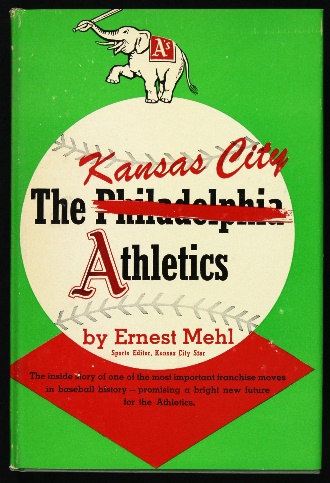
The Texans to KC in 1963: Dallas had two pro football teams founded in 1960 – The Dallas Cowboys of the NFL and the Dallas Texans of the AFL. The Cowboys were the dominant football team in the city, and Texans owner Lamar Hunt was reluctantly resigned to moving his team. After the 1962 season, Kansas City mayor H. Roe Bartle and the KC business community united to lure the Texans to Kansas City, including a promise to expand Municipal Stadium with new permanent stands on the east and temporary stands on the north (left and center field of the baseball field). The effort to get the team was strongly supported by the Kansas City Star and its Sports Editor Joe McGuff (who wrote a book about it). Bartle’s term in office ended on April 10, 1963. He was succeeded by Ilus Davis who was mayor for the Kansas City Chiefs inaugural game on September 14, 1963.

Trivia Note: The #87 on the book cover is of course not Travis Kelce. It’s Aaron Brown, an excellent defensive end who played for the Chiefs in Super Bowls I and IV.
H. Roe Bartle, Colossus: Public comments on Bartle’s imposing size were not unusual. Bartle’s Wikipedia page relies on three different sources for this coverage:
“Bartle, who was 6’ 4”, weighed well over 200 pounds before his marriage, and he continued to gain until at one point he may have reached 375…Bartle insisted on waffles every morning ‘swimming in butter and syrup,’ and he enjoyed dinners of meat (no chicken or eggs), potatoes, gravy, salad, bread and dessert. His wife unsuccessfully tried to persuade him that he did not also need four or five slices of buttered bread with these meals.”
In 1956, the Kansas City Star reported that “Bartle, an impressive figure in a specially-tailored, outsized A’s uniform,” threw out the ceremonial first pitch for the A’s. The Star ran an artist’s sketch of the pitch.

The Kansas City Times ran a photo of Bartle in his uniform, but the online version is unfortunately too dark to copy. However, the caption is priceless:
“PROBABLY THE HEFTIEST BATTERY the Kansas City Athletics ever had or hope to have took the field yesterday in the home opener against Chicago. The first pitch from Mayor H. Roe Bartle, 278 pounds, fell some five feet short of home and bounced into the glove of his catcher, Mayor Paul F. Mitchum of Kansas City Kansas. Bartle tried again, and the toss made home plate. Mitchum weighed 230.”
To give some perspective, here is Bartle with former president Harry Truman at the Truman Library in 1963.
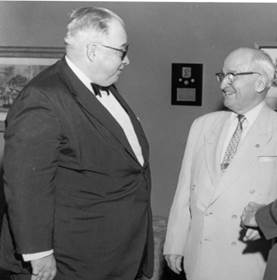
In 2020, just before the Chiefs won Super Bowl LIV, Forbes ran an article about Bartle titled “The True Tale of the Original Kansas City Chief.” The article recounts how the Chiefs team name was “borrowed from a king-size politician” who “threw his considerable weight around” to get Lamar Hunt to move the Texans to Kansas City. “H. Roe Bartle was a colossus, 6-feet-4 and up to 400 pounds, who loved waffles and smoked 25 cigars a day.”
Next up, the puzzle pieces for the story of the custom box seat for Mayor Bartle.
First Piece of the Puzzle – Chris Burford and Bill Wakefield: When I started Hot Stove in late 2015, an early subscriber was Chris Burford who I crossed paths with in law school and at my first law firm job at Popham. Chris attended law school while also being a superb split end for the Kansas City Chiefs.
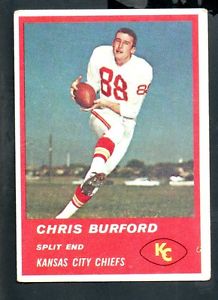
In April of 2016, Chris sent an email to me and my long-time law partner Jim Polsinelli (and a fellow UMKC Law School student), attaching a message from “a Stanford friend who grew up in KC and pitched for the Mets.” His Stanford friend was Bill Wakefield who was a sports star in the late 1950s at Pem Day and whose baseball career included the 1964 season with the Mets.
Part of Wakefield’s message to Chris was about the special box seat the Kansas City A’s had constructed for Bartle in a box seat section\ behind the A’s dugout (converting two seats into one double-wide seat). “My mom and Mrs. Margaret Bartle were good pals from KC Theater (Young Matrons). Roe traveled a lot. When he was out of town, Margaret would call my mom, and they went to many games, comfortably sharing Roe’s custom-built double-wide seat.”
Coincidentally, I already knew Wakefield because he had been added to the Hot Stove mailing list by my law partner Irv Blond (who overlapped with Wakefield at Pem Day). The small world of Kansas City.
The Burford email was nine years ago, and I had forgotten about it. But I went back to retrieve it when another piece of the puzzle was added last year…
Second Piece – Bill Wakefield Again: Last year in a Hot Stove, I included a film clip of an A’s game from the 1950s. It reminded Wakefield of his mother going to the games, and he sent me an email like the one he sent nine years ago to Burford:
“My mom Roberta Wakefield and Roe’s wife, Margaret Bartle were good friends. In a variety of theater events together. The A’s gave Roe a double-wide seat close to the dugout. Margaret was a big baseball fan. When Roe was out of town (frequently), she would take my mom on a last-minute notice to a game. They shared Roe’s double seat. Sam’s parking was comped.”
Below, a photo from the Truman Library archives – Margaret Bartle watching Harry Truman play the piano at the Truman Library (1961).
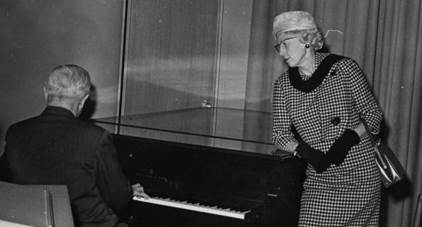
Wakefield Trivia: Wakefield had a good year pitching for the Mets in 1964, appearing in 62 games with an ERA of 3.61. The next two seasons, he was in spring training camp long enough to be in the Topps baseball sets for the Mets in 1965 and 1966 even though he only played in the minors those years. But his cards survive and have value, especially to those trying to assemble complete sets. A mint condition 1966 card of Bill’s sold at auction a few months ago for $4,920!
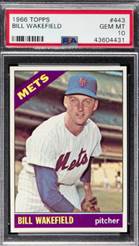
Last fall, Bill was in town for his 65th class reunion at Pem Day. We had lunch at one of his favorite high school hangouts, Winstead’s on the Plaza. His daughter Amy joined us and took this photo of two guys from the Class of 1959 (him, Pem Day; me, Van Horn).
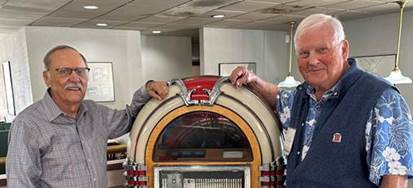
Third Piece – Paul Peterson: In the 1970s, I did legal work for Stan Plesser and Paul Peterson whose Good Karma Productions represented music artists, including Brewer & Shipley, Danny Cox and the Ozark Mountain Daredevils. They were also record producers and concert promoters (including the Cowtown Ballroom). You have read about them before in Hot Stove.
After his time with Good Karma, Paul moved to California to continue his work in the music industry. Last year, he wrote a book about his 50-year career (and yes, the “high” times refers to marijuana).
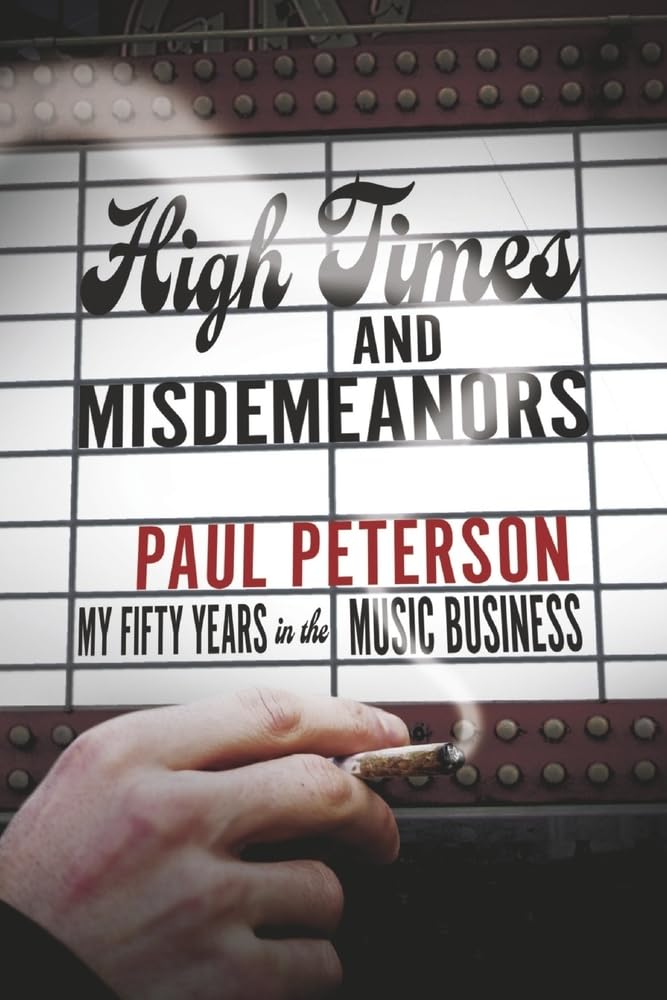
The book includes memories of his time at Southwest High School in the 1960s. He tells two Municipal Stadium stories. He was there for the Beatles when Charlie Finley brought them to KC in 1964. But it was a story from about 1960 that really caught my attention:
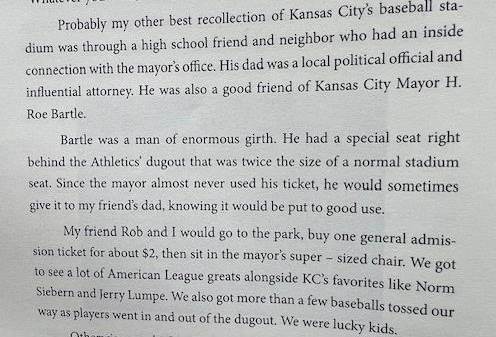
As soon as I read this, I contacted Paul to find out who the “influential attorney” was. He said it was Al Thomson, as in Linde Thomson, a major firm back in those days. Thomson was a civic leader and a member of the Kansas City Police Board. His son Rob is a practicing lawyer in Kansas City, so I contacted him for his memories of the double-wide seat.
Rob Thomson: “I would pick up the tickets from Mayor Bartle’s condo on the Plaza, and he would always be in his pajamas. Then on Saturday we would hop on the Country Club bus-line at 63rd and Brookside, get off at 39th Street to transfer to the Brooklyn line to take us to the stadium. We would always arrive for batting practice and seldom left empty handed (but game balls were preferred). We sometimes had three of us in the mayor’s double seat.”
Fourth Piece – Jim Klein and Family: In Hot Stove #87 (11/9/18), I ran this photo of former president Harry Truman throwing out the first pitch for the inaugural A’s opener on April 12, 1955. The A’s manager in the photo is Lou Boudreau, and the Tigers manager is Bucky Harris. Behind Harris at the far right is A’s owner Arnold Johnson. I was also at the game with my 8th grade pal Jay DeSimone, but our seats were high in the upper deck over right field.
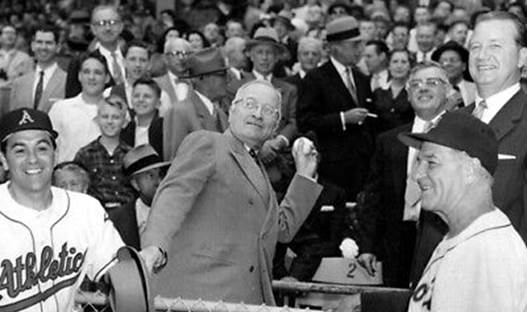
I got a return email from Jim Klein, a Hot Stove subscriber who had been added to the mailing list by his friend Stan Bushman (RIP). Jim said members of his family were in the photo just behind Truman. I thought that was a cool fact, but did not think about it again until six years later when I got the Wakefield and Peterson stories about the double-wide seat. Was it possible that Jim also knew about the Bartle seat?
I contacted Jim and hit a gold mine. Before I get to the details, I need to recount some Kansas City history.
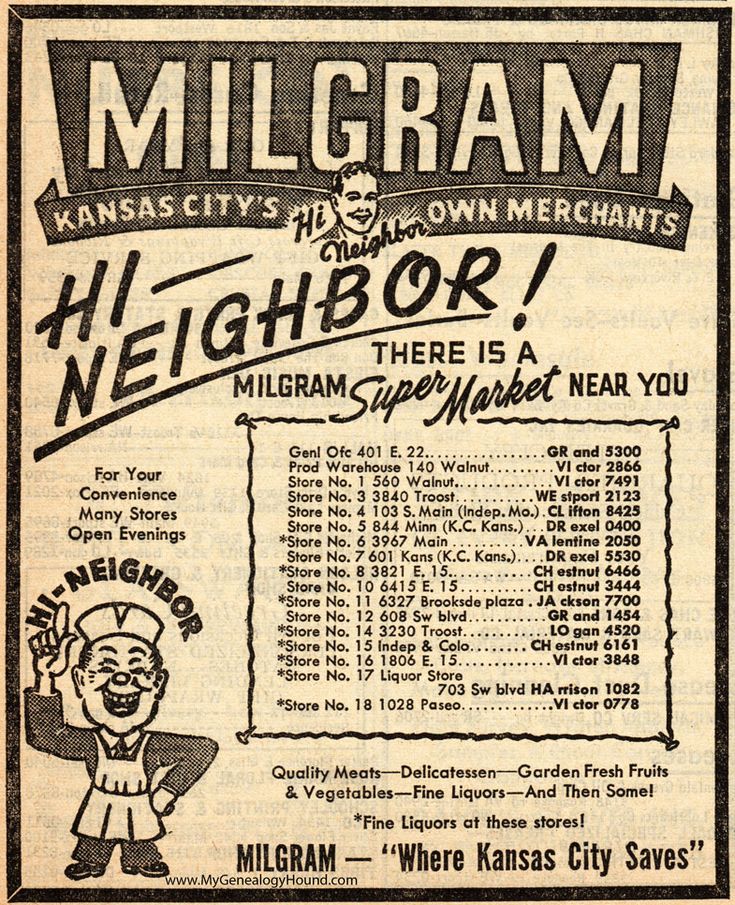
Nat Milgram opened his first grocery store in 1913. In 1928, after he had expanded to 37 stores, he sold the chain to Kroger. In 1932, he reentered the grocery business, and “Hi Neighbor!” became the motto of the new Milgram’s chain. It was run as a family business with Nat’s son Lester and sons-in-law William Klein and Stuart Wien taking senior leadership positions. The company was known for its commitment to causes benefiting Kansas City, and one of the best examples was Les Milgram’s influential involvement in bringing the A’s and Texans to Kansas City.
Nat died in 1958, and Les became chair of the company. Les died in 1976, and Klein and Wien ran the company until it was sold in 1984.
Now, let’s return to the Truman photo above. At the upper left, the tallest man is Les Milgram. To his right is Stuart Wien. To his left, the man with the bow tie, is Nat Milgram.
For the rest of the Milgram’s part of this story, I’ll switch to another photo I found in the Truman Library online archives.

Per Jim Klein, the “owner’s box” consisted of two 4-seat rows behind the A’s dugout. The next two rows were the Milgram’s seats. In this photo from opening day on April 9, 1963, the first row of the owner’s box is occupied by (l to r) Shirley Finley, Bess Truman, Harry Truman and A’s owner Charlie Finley. In the third row, the man with the big smile is Les Milgram, and to his left are family members, including William Klein (with sunglasses).
The Milgram family was very close to Mayor Bartle and arranged for two of their seats to be converted to a bench for the mayor’s comfort. Jim Klein believes it was the two seats behind where Les is sitting.
Willam Klein’s sons Jim and Rob, and Stuart Wien’s son Bill, were grade school age in the early 1960s and attended many games in the Milgram’s section. All three have confirmed not only the existence of the Bartle seat, but that they often sat there when the double-wide seat was not occupied. Rob Klein: “I distinctly remember sitting in Roe Bartle’s double seat as a “peanut,” as Dad would say, usually aside big brother Jim, honing my mastery of speed-eating frosty malts.”
Fifth Piece – George Toma: As for who else might know about the Bartle seat, I thought of George Toma. He dated back into the 1950s as the A’s groundskeeper. I didn’t personally know George, so I contacted Joe Ungashick who has a Wiffle ball field next to his home on Wornall Road across from Loose Park. The designer, consultant and namesake for the field is George Toma. Ungashick makes the field available to local kids and for charity events.
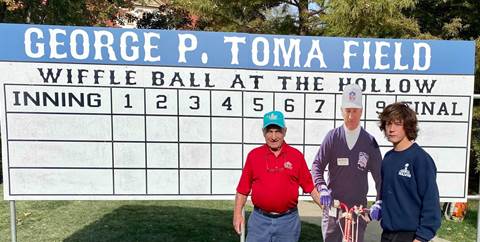
Joe put me in touch with the 96-year-old Toma, and we had a delightful phone call. George confirmed the existence of the double-wide seat, but he was unfamiliar with its installation because it was already there when George joined the A’s in 1957.
I then went to the second reason I wanted to talk to George. In his 2002 book (George Toma: Nitty Gritty Dirt Man), George told a story about being on an airplane to Atlanta. He was headed there to interview with the Braves and Falcons, potentially a big loss for Kansas City. Mayor Bartle was on the plane, and George says that Bartle “personally made sure…that I did not take the Atlanta Braves and Falcons job. The mayor used both seats next to me on that flight.”
George confirmed the airplane story. “He was big and took up two seats.” Just like at Municipal Stadium.
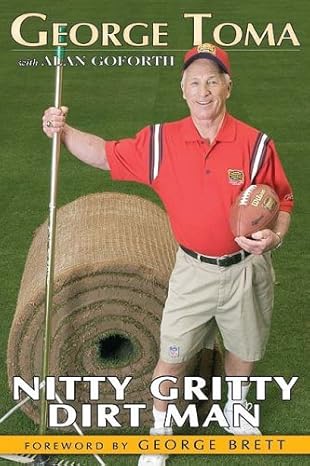
Sixth Piece – 1955 Opening Day Photo: I have been unable to locate a photo of the double-wide seat. The only photo I could find (KCPL) of Mayor Bartle in a seat at Municipal Stadium is one from opening day in 1955. Luckily, it adds to the story. Bartle is sitting up to the front of his single seat. Looking uncomfortable. I can see why a double-wide seat would be a good idea.
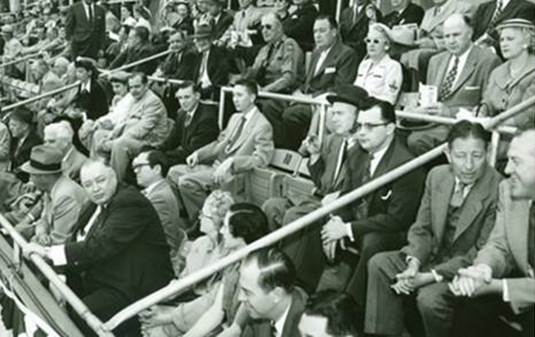
There is some other KC history in this photo. The day before this picture was taken, Bartle had been sworn in as mayor. His predecessor, Mayor William E. Kemp (the mayor who brought the A’s to Kansas City) is the third person to Bartle’s right (the man with the white hair). In the top row, to the trooper’s left, is Lt. Governor James T. Blair (later governor from 1957 to 1961). With identification help from Irv Blond and Ron Bodinson, the two men on the other side of the trooper are Larry Bodinson (Ron’s dad), long-time chief KC aide to Congressman Richard Bolling, and, wearing a hat, Tom Evans, owner of Crown Drugs and a close friend of Harry Truman. I had the pleasure working on campaigns with Larry Bodinson when I was chair of the Jackson County Democratic Committee in the 1970s. Bill Wien spotted one of the businessmen who worked with Mayor Kemp to get the A’s to KC; near the far right of the photo, with hair parted in the middle, is Alex Lewi, president of KC’s Macy’s stores (where Rita worked in high school and college).
The puzzle is complete!

Lonnie and the Chief: The Boy Scout camp that Bartle founded in Osceola is still active and is now known as the H. Roe Bartle Scout Reservation. The honor society that Bartle created for veteran campers, the Tribe of Mic-O-Say, is also still active.
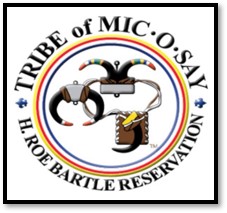
I attended a 10-day session at Camp Osceola (as then known) during five summers (1953-1957). In my fourth year (age 14), I was “called” to join the Tribe of Mic-O-Say. “Call” night came while hundreds of scouts gathered on stands around a big campfire to listen for the names of those to be honored. When called, we left our seats and went to the ring around the campfire. We were given instructions about the initiation process which included being on “silence” for 24 hours and camping on our own that night. Then a scout leader came up, grabbed you by the arms, and yelled “Do you understand me?” He was making sure we knew the rules. I, like most, said “yes.” That was bad. After all, I was on silence. What was I doing talking already? The next yell was a demand to “Leave this council ring!” which was aided by physically throwing us out to spend our lonely night in the woods. Sorry this is such a long story, but it’s necessary for the punchline. The leader who shook me hard, yelled loudly with a booming voice, and threw me out of the council ring, was H. Roe Bartle (a/k/a Chief Lone Bear). He was now Kansas City’s mayor but still made regular visits to Osceola.
I went one more year to Camp Osceola and became a “Warrior” in Mic-O-Say. I assumed I would continue for more years, but I turned 16 and got my driver’s license. Goodbye Boy Scouts.
Bartle (RIP): H. Roe Bartle died in 1974 at the age of 72. Hail to the Chief!
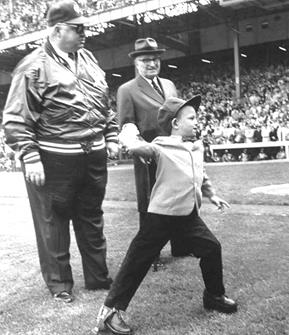
Lonnie’s Jukebox – H. Roe Bartle Edition: Mayor Bartle’s term in office took us from the dawn of rock ‘n’ roll to the dawn of the British Invasion. Today’s Jukebox features selections from each year of his term.
“Rock Around the Clock” by Bill Haley and the Comets (1955).
“Don’t Be Cruel” by Elvis Presley (1956).
“I’m Walkin’” by Fats Domino (1957).
“Rockin’ Robin” by Bobby Day (1958).
“Dream Lover” by Bobby Darin (1959).
“Walk, Don’t Run” by the Ventures (1960).
“Tossin’ and Turnin’ by Bobby Lewis (1961).
“Green Onions” by Booker T. & the M.G.’s (1962).
“He’s So Fine” by the Chiffons (1963).
In February of 1964, the Beatles appeared on Ed Sullivan. The British Invasion was underway.
Walk-Off Photo #1: Rita and I have our own series of photos with Harry Truman. For the last several years at the “Wild About Harry” fundraiser for the Truman Library, there has been a green screen photo opportunity. This year’s event was last Thursday, and we posed with two presidents.
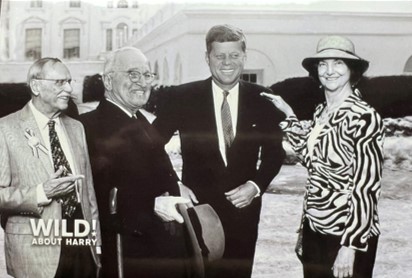
Walk-Off Photo #2: A group of individuals and organizations have contributed to an 8,100 square foot sign on the north wall of the Mainmark Building at 1627 Main. There is a companion website promoting Washington Square Park as the location for a new Royals stadium. Click here (“It’s the bottom of the 9th and we need a rally!”).
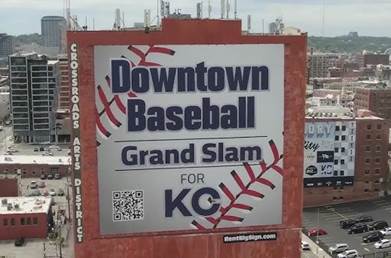
I like it. I think Les Milgram would too.